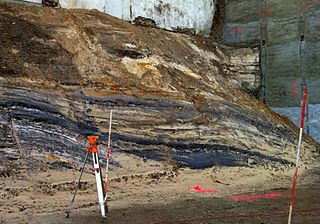Related Research Articles
The Rupelian is, in the geologic timescale, the older of two ages or the lower of two stages of the Oligocene epoch/series. It spans the time between 33.9 and28.1 Ma. It is preceded by the Priabonian stage and is followed by the Chattian stage.

The Molasse basin is a foreland basin north of the Alps which formed during the Oligocene and Miocene epochs. The basin formed as a result of the flexure of the European plate under the weight of the orogenic wedge of the Alps that was forming to the south.
The Houthem Formation, named after the Dutch town of Houthem, is a geological formation that crops out in the south of Belgian and Dutch Limburg. It has also been found in borings in the northeastern part of the Campine Basin. The formation consists of calcareous sandstone and was formed about 60 million years ago, in the Paleocene epoch.

The Aachen Formation is a Late Cretaceous geologic formation in the southern Netherlands and northeastern Belgium and adjacent Germany.
The Landen Formation is a lithostratigraphic unit in the subsurface of the Netherlands. This formation shares its name with the Belgian Landen Group, but the Belgian unit is thinner and has different definitions. The Landen Formation consists of shallow marine and lagoonal sediments from the late Paleocene to early Eocene. Dutch stratigraphers see the Landen Formation as part of the Lower North Sea Group.
The Hannut Formation is a geologic formation in the subsurface of northern Belgium. The formation consists of marine clay and silt, alternating with moer sandy layers. On top of this the lithology changes to limestone, siltstone and sandstone and the top of the formation is formed by a layer of glauconite bearing sand. The Hannut Formation was formed during the early to middle Thanetian age.
The Heers Formation is a geologic formation in the subsurface of Belgium. The formation consists of sand and marl and was deposited in the shallow sea that covered Belgium during the middle to late Selandian age of the Paleocene epoch.
The Dongen Formation is a geologic formation in the subsurface of the Netherlands. The formation consists of early Eocene marine clay and sand. It is named after the town of Dongen in North Brabant.
The Rupel Group is a stratigraphic group of rock strata in the subsurface of Belgium. It is subdivided into three formations that are all marine deposits of Oligocene age.

The Breda Formation is a geologic formation in the subsurface of the Netherlands. The formation consists of marine glauconiferous sands and clays that were deposited during the Miocene epoch. Although the formation is not very rich in fossils, sometimes bones of fishes, mammals, shells and shark teeth are found.
The Middle North Sea Group is a group of geologic formations in the Dutch subsurface, part of the North Sea Supergroup. The three formations of this group form a thick sequence of sediments in the Dutch subsurface, they crop out in parts of the southern Netherlands. The Middle North Sea Group was deposited from the late Eocene to late Oligocene, between 37 and 23 million years ago.
The Tongeren Formation is a geologic formation in the subsurface of the Netherlands. The formation consists of shallow marine, epicontinental and continental sediments, predominantly clay and sand from the late Eocene and early Oligocene epochs. The Tongeren Formation is part of the Middle North Sea Group and correlates with the Tongeren Group from Belgian stratigraphy.
The Aalter Formation is a geologic formation in the subsurface of northwest Belgium. The formation consists of marine clay and sand, deposited in the shallow sea that covered northern and central Belgium in the Eocene epoch.
The Gentbrugge Formation is a geologic formation in the west of Belgium. The formation crops out in East- and West-Flanders and also occurs in the subsurface of the province of Antwerpen. It consists of marine clay, silt and sand, deposited in the shallow sea that covered northern Belgium during the Ypresian age.
The Veldhoven Formation is a geologic formation in the subsurface of the Netherlands. The formation consists of an alternation of marine clay and sand from the Oligocene epoch.
The Voort Formation or Voort Member is a stratigraphic unit in the subsurface of north Belgium and the south of the Netherlands. The unit has the status of a formation in Belgium but is seen as a member of the Veldhoven Formation in the Netherlands. The Voort Formation consists of shallow marine sands with a late Oligocene age.
The Maldegem Formation is a geologic formation in the Belgian subsurface. The formation consists of alternating marine clay and sand strata, deposited during the late Eocene.
The Brussel Formation is a geologic formation in the subsurface of central Belgium. The formation is named after the Belgian capital, Brussels. It consists of shallow marine sandstone and calcareous sands, deposited in the sea that covered Belgium 45 million years ago, in the Eocene.
The Tongeren Group is a lithostratigraphic unit in the subsurface of Belgium. It consists of shallow marine, epicontinental and/or continental clays and sands from the late Eocene to early Oligocene epochs.
The Bouldnor Formation is a geological formation in the Hampshire Basin of southern England. It is the youngest formation of the Solent Group and was deposited during the uppermost Eocene and lower Oligocene.
References
- Adrichem Boogaert, H.A. van & Kouwe, W.F.P. (eds.); 1993: Stratigraphic nomenclature of the Netherlands, revision and update by RGD and NOGEPA, Mededelingen Rijks Geologische Dienst 50, pp. 1–39
- Dumont, A. ; 1849: Rapport sur la Carte géologique du Royaume, Bulletin de l'Académie royale de Belgique 16 (2ième partie), p. 370 ((in French))
- Kuyl, O.S.; 1975: Lithostratigrafie van de Mio-Oligocene afzettingen in Zuid-Limburg, in: Zagwijn, W.H. & Staalduinen, C.J. van (eds.): Toelichting bij geologische overzichtskaarten van Nederland, Rijks Geologische Dienst, Haarlem, pp. 56–63. ((in Dutch))